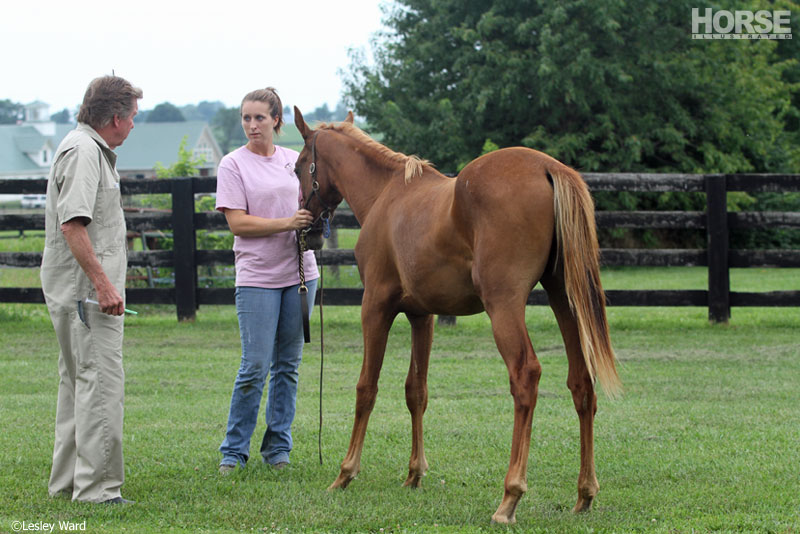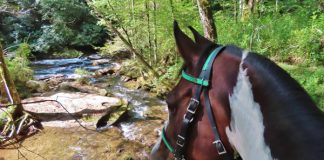Gelding, or castration, is the most common equine surgical procedure performed on horse farms. Although veterinarians use different techniques, all routine castrations adhere to the same basic process and aftercare practices. Here are the basics that you should know if you own a colt or stallion that will be undergoing gelding surgery.

Testicles fully descend from the abdomen into the scrotum by roughly 1 to 2 years of age in horses. Most veterinarians recommend gelding as soon as both testicles have descended. The younger the colt is at the time of gelding, the easier the procedure, as blood vessels to the testicles are smaller in young animals. This means there is less bleeding at the time of surgery.
A basic gelding can be performed with the horse either standing or lying down—it usually depends on the veterinarian’s personal preference.
Anesthesia
The first step in equine castration is sedation. The initial amount of sedation given prior to gelding is based on the horse’s estimated body weight and temperament. Most commonly, the sedative is administered via an intravenous (IV) injection in the jugular vein. Given this way, the drugs take effect very quickly, and within minutes the horse will appear quiet and relaxed, with a lowered head, droopy lower lip, and a hind leg bent and resting on the toe. At this point, the veterinarian may palpate the horse’s testicles to make sure both are descended.
If the horse is to be castrated lying down, the anesthetic drugs used to make him unconscious will be administered next. If a standing procedure will be performed, these medications will not be given; instead, the testicles and scrotum will be blocked with a local anesthetic.
The administration of anesthetic drugs to a horse on the farm is a well-orchestrated series of events that requires everyone to be attentive. After the drugs are given IV, they take effect immediately. The sedated horse will begin to stumble and then drop to the ground. A large area clear of clutter is imperative for this step; as the horse is lying down, he has little control over his movements and could be injured on anything in the way. Procedures can occur out in the pasture, in the riding ring, or wherever there is plenty of light.
Once the horse is down, most veterinarians would prefer him to be on his back with one or both hind legs in the air. Since the anesthesia lasts for a finite period—usually between 15 and 30 minutes—the vet must work quietly and efficiently to prep the surgical site, perform the castration, and clean up before the horse awakens and attempts to rise.
Gelding Surgery
Both the standing and recumbent methods of castration are surgically performed the same way. After scrubbing the surgical site, the vet will make two incisions into the scrotum, one over each testicle.
Most veterinarians use an instrument called an emasculator for removing the testicles. It both crushes and cuts the spermatic cord. Crushing is required to prevent bleeding. If the horse is a large colt or an adult, the vet will also likely place stitches called ligatures around the cord to further prevent bleeding. These ligatures are made of absorbable suture material and will not need to be removed.
Once the testicles have been removed, the incision is left open. This is a very important part of the castration procedure, as it allows the surgical wound to drain slowly over the course of a week or two, reducing the chance of excessive, painful swelling.
After the surgery is finished, the horse will be positioned on his side and allowed to wake up from anesthesia. He will be groggy and unsteady when he first attempts to stand, so be sure to stand clear and give him room to find his balance. Once he’s steady and quiet, take him to his stall, a quiet paddock or a round pen. Remove all feed, even hay, until he’s is fully awake, which is generally within a few hours.
An adult horse with only one descended testicle is called a cryptorchid, sometimes colloquially referred to as a “ridgling” or “rig.” An undescended testicle can be in an intermediate location between the abdomen and scrotum. These horses are sometimes called “high flankers” and can usually still be castrated on the farm. An undescended testicle can also occasionally be retained completely within the abdominal cavity. These cases often require more extensive surgical exploration to locate and remove the testicle and may need to be referred to a veterinary hospital.
Post-Op Care for Gelding
It’s essential to closely monitor the horse’s overall demeanor and his surgical site for the first few weeks following castration. Some drainage will drip from the open incision for up to two weeks. This drainage will at first appear bloody, and then over time it may take on a more serum-like appearance. Mild to moderate swelling of the scrotum is also likely to occur, even with the open drainage. Frequently, swelling will travel along the sheath. This is normal and is not severe enough to interfere with urination.
While the area is draining, debris may collect along and between the horse’s hind legs. In the summer months, this may attract flies, so strict fly control is essential to help prevent infection at the incision site. Many vets prefer to perform castrations in the spring or fall to avoid fly season. If drainage is bothering the horse, cold hosing once a day for the first week or so can help keep the incision clean, help decrease swelling and inflammation, and make him feel better.
Over the next two weeks, the horse needs unmounted exercise. Movement will help encourage drainage and decrease swelling. Some horses may be stiff and not feel like moving, so just turning the horse out in the pasture is generally not sufficient. Daily longeing at the trot is often recommended. The open incisions should close by roughly three weeks. Normally, after four weeks, the horse is healed enough to return to work or training.
For pain management, many vets will administer a dose of an anti-inflammatory medication at the time of surgery. Oral phenylbutazone (bute) for a few days post-surgery may also be prescribed.
Veterinarians vary in their opinions on the use of preventive antibiotics post-castration. If there were complications or a breach in sterility during surgery, or if there is a question of whether the horse will be able to be closely monitored or kept clean during post-op care, the vet may choose to start him on a course of broad-spectrum antibiotics. Otherwise, such medications generally aren’t needed. Another common prophylactic measure post-castration is a tetanus booster.
Complications
Although castration is a very common procedure, it is still surgery and should not be dismissed as simple or routine. A few complications can occur.
1. Post-operative hemorrhage: After gelding surgery, a slow drip of blood from the incision is acceptable, but a steady, fast drip or flow of blood is not. If excessive bleeding occurs during the surgery, the veterinarian may pack the incision site with sterile gauze, which can be removed in a few hours. This usually provides enough pressure on the bleeding vessel to stop the hemorrhage. In rare cases when post-op bleeding is profuse, the horse will have to be anesthetized again so the vet can search for the leaking blood vessel, clamp it and tie it off with a stitch.
2. Excessive swelling: Another possible complication is caused by premature healing of the incision site. If it closes too soon, drainage can’t occur and fluid will accumulate in the scrotum. This is not only uncomfortable for the horse, but it also increases the risk of infection. If the incision heals too quickly and results in excessive swelling, your veterinarian will usually re-open it to allow more time for drainage.
3. Infection: This is always a possible complication in an open incision. By monitoring drainage, you can tell if an infection is present; drainage should never smell bad or appear thick. Heat from the surgical site and a horse that is acting lethargic, is off his feed or has a fever are all signs of infection. If this is the case, the vet will re-examine the area. Depending on the infection, the site may be flushed with antiseptic and opened further if necessary; a course of antibiotics could be prescribed as well. Rarely, infection travels up the stump of the remaining spermatic cord. This condition is called a “scirrhous cord” and requires a second surgery to remove the cord that harbors infected tissue.
4. Eventration: This is an extremely rare but life-threatening complication of gelding. This occurs when tissue, either intestine or abdominal fat called omentum, protrudes through the incision. Monitoring the site at least twice daily will help catch most complications in a timely manner. During the first day or so after surgery, you may see a small blood clot, which is normal. If you see something other than this hanging from the incision site, or you are unsure what you are seeing, call the vet immediately.
Understanding the basics of equine gelding and aftercare will help you be more comfortable if you ever have a horse undergo this procedure. Knowing how to care for your horse post-operatively will help set you up for a complication-free experience.
This article originally appeared in the March 2014 issue of Horse Illustrated magazine. Click here to subscribe!






That was very interesting and I enjoyed learning about it!
Very helpful, as I have a young horse that will require gelding soon.
Thanks
Fascinating.